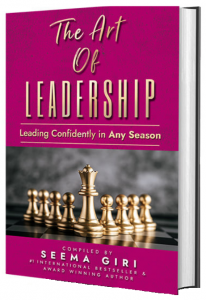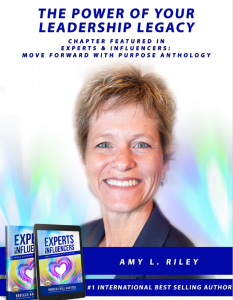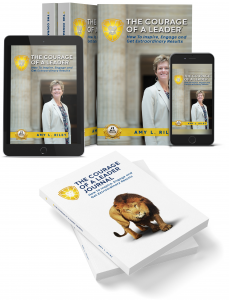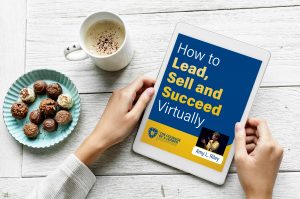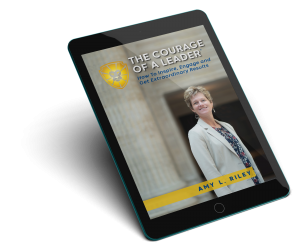So many leaders ask me: How do I get people excited about and ready for the new year? We’ve dealt with a lot this year. How do we re-group and re-energize to start the year off strong?
In this episode, I’ll share what it takes to inspire ourselves and our teams, and give you concrete guidance and examples of how to do so.
About the Host:
Amy L. Riley is an internationally renowned speaker, author and consultant. She has over 2 decades of experience developing leaders at all levels. Her clients include Cisco Systems, Deloitte and Barclays.
As a trusted leadership coach and consultant, Amy has worked with hundreds of leaders one-on-one, and thousands more as part of a group, to fully step into their leadership, create amazing teams and achieve extraordinary results.
Amy’s most popular keynote speeches are:
The Courage of a Leader: The Power of a Leadership Legacy
The Courage of a Leader: Create a Competitive Advantage with Sustainable, Results-Producing Cross-System Collaboration
The Courage of a Leader: Accelerate Trust with Your Team, Customers and Community
The Courage of a Leader: How to Build a Happy and Successful Hybrid Team
Her new book is a #1 international best-seller and is entitled, The Courage of a Leader: How to Inspire, Engage and Get Extraordinary Results.
https://www.linkedin.com/in/amyshoopriley/
Links mentioned in the episode
Inspire Your Team assessment: www.courageofaleader.com/inspireyourteam
Call to action
Declare your leadership legacy
Take the Inspire Your Team assessment: www.courageofaleader.com/inspireyourteam
Thanks for listening!
Thanks so much for listening to The Courage of a Leader podcast! If you got inspired and/or got valuable leadership techniques you can use from this episode and think that others could benefit from listening, please share using the social media buttons on this page.
Do you have questions or feedback about this episode? Leave a comment in the section below!
Subscribe to the podcast
If you would like to get automatic updates of new The Courage of a Leader podcast episodes, you can subscribe to the podcast on Apple Podcasts. You can also subscribe in your favorite podcast app.
Leave us an Apple Podcasts review
Ratings and reviews from our listeners are extremely valuable to us and greatly appreciated. They help our podcast rank higher on Apple Podcasts, which helps us ignite The Courage of a Leader in more leaders! Please take a minute and leave an honest review on Apple Podcasts.
Teaser for next episode
Our next episode comes out next week! Nancy Rizzutto is my guest. She is a visionary. She’s clear about her purpose and she shares with us about: How to Inspire Others to Live Abundant and Meaningful Lives.
Transcript
Every time I'm inspired. Every time a leader inspires me to do something I haven’t before. Every time I see a leader is suddenly thinking and achieving in a new way. Every time I’m so impressed by the extraordinary results someone has achieved. Every time I’m in awe of what a team has been able to accomplish. Every time, one of those scenarios is true, those involved have demonstrated The Courage of a Leader. Every time. Courage is the constant variable.
You can't inspire yourself or others, if you don't have courage.
Do you want to be a leader who inspires, engages and gets extraordinary results? Then you want to practice intentionally demonstrating the Courage of a Leader.
How? Let’s look at The Courage of a Leader 4 Pillars. The Courage of a Leader 4 Pillars were created based on my over 2+ decades of experience consulting with Fortune 50 companies, coaching executives, and developing leaders at all levels. I noticed that inspiration was always tied to demonstrating courage. Always. And there are 4 Pillars of The Courage of a Leader that I have noticed and defined.
The Courage of a Leader 4 Pillars are:
The courage to be authentically you
The courage to say what needs to be said
The courage to trust the legacy - that's YOUR leadership legacy
The courage to be bold and create the extraordinary
Let's talk about each.
The courage to be authentically you.
The most powerful and courageous way to be authentically you is to declare your leadership legacy and to use your leadership legacy as aspiration and guidance daily. If you haven't heard me talk about leadership legacies, let me briefly explain. A leadership legacy is an aspiration about how you want to be known or what you want to create. It's a bigger picture commitment, the purpose of your leadership. What you bring to every interaction, every relationship, every part of your work, every initiative.
How do you uncover and declare yours? Think about where and how you provide value. Make a list. Think about what types of activities energize you. Make a list. You could reflect for a week, maybe at the end of the day, during your commute home (if you have one of those!) or while you’re drinking your coffee in the morning. How did you provide value that day or the previous day? What energized you during the day? And keep adding to both of these lists. Then, look across these lists for themes. Where the 2 lists overlap, that’s the area of your leadership legacy.
Declare yours! There’s no need to wait. Having a leadership legacy, a bigger picture purpose, has you being bold and going beyond normal human considerations. It has you getting known for the work you most want to do and leveraging your strengths to do more with less.
Once you’ve declared your leadership legacy. Then….
Use your leadership legacy as guidance. When there are tough choices to make, ask yourself what your legacy wants. Kristin Colber-Baker, the Global Head of Talent Development at Mars, did just that. There was a time she was hearing lukewarm responses to the proposed idea of designing a leadership development program for mid-level female managers. Her leadership legacy of “faithfully developing myself and others” would not allow Kristin to let it go. She was clear that her legacy wanted this development opportunity for these females in middle management. Ultimately, she went back and said that she wasn’t asking; she planned to move ahead. She was committed to offering this program. Her leadership legacy and bigger picture commitment had her being bold and assertive. Today, Mars offers that program, and it has received some of the highest net promoter scores—or learner satisfaction levels—that Harvard Business School has ever seen.
Continually live into your legacy. Leave evidence of your legacy wherever you go. Consider how you bring it to each interaction, each and every day. “How well did I live out my leadership legacy?” can now be the barometer for your day.
The courage to say what needs to be said. Let’s talk about this pillar.
You’re a leader, and you have a tough message to deliver. Or, you have constructive feedback to give. Or, you need a person’s behaviors to change or performance to improve.
How do you say what needs to be said without crushing a person’s spirit, demotivating others, or putting someone on the defensive? Is there a way to say what needs to be said, so others feel supported and empowered? So they get more done faster and better?
There is. You’ve got to check your intentions, self-edit, and stick to the facts.
Before you run off to deliver the bad news or hide in your office to put it off as long as possible, check your intentions. What is the ideal outcome? What is this tough message in service of in the big picture? There’s always a positive intention. Too often, we get stopped at our concerns about how the person is going to take it or what they’ll think of us as a result. You want to push past these concerns and identify the positive intent.
I like to say that “belief eats behavior for breakfast.” Playing off of the well-known saying that “culture eats strategy for breakfast.” Belief eats behavior for breakfast. Ensuring our beliefs are empowering and tuning into the positive intent is way more important than trying to robotically get some set of behaviors exactly right. There are times when someone is seemingly saying or doing all the right things, yet we don’t buy it. It’s because the person’s beliefs are not fully in alignment with what they’re saying.
The next technique is self-editing. Editing ourselves! Courage is definitely needed here! You need to take a close look at what all is going on within yourself. Only then can you know what to edit out of your message because it’s more about you, your knowledge, or your ego than it is about growing the person, improving the person’s performance, and/or delivering a message that can be clearly understood and absorbed. It takes courage to take an honest look at yourself and edit yourself to say only what needs to be said.
Here are some ways we might self-edit.
You may know exactly what you’d do if you were in the person’s shoes… Yet, if it’s more important for the person to own the outcome and/or develop in this area, then you might want to discuss the desired outcome only. Let him decide how.
You may be able to clearly point out a handful of things a person did wrong… Yet, if you want this person’s confidence to grow, it may be more impactful to point out a couple of key strengths to leverage and/or how she can use her strengths to address one of the things that didn’t work as well as it could have.
Let me give you an example.
When I started working with Rosa, she was a fairly new manager of managers. She took her leadership role to heart and thought intently and intentionally about how to provide the best leadership to the team. The greenest leader in her group, Tarek, was someone she had hired into the company. He was enthusiastic and full of ideas, and Rosa was excited about him making his mark in the division. She assigned him a visible and strategically important project to lead.
Halfway through the project timeline, Rosa engaged in a pretty extensive feedback process. She wanted to be able to praise Tarek and finetune his performance. Instead, what Rosa learned was disappointing. Tarek hadn’t checked back in with the project sponsor since the project launch. It also seemed Tarek felt it was okay to go over on a budget item. She learned that he wasn’t telling other departments why he needed the information he was requesting. And finally, he hadn’t been escalating issues appropriately to department heads.
Rosa wanted to meet with me about this. She told me there are so many key aspects to the project that Tarek wasn’t handling well. She was surprised and frustrated. I asked Rosa for her plan. “I’ve got to sit him down and tell him all this.” I asked how he’d respond. She thought this would devastate him. She was afraid it would shake his confidence. But she couldn’t have him go on like this. Things needed to change. I agreed. Yet, I challenged: “What if I told you to only give him two pieces of feedback?” Rose looked at me, incredulously. “Really,” I said. “Pretend for a moment. What two pieces of feedback are most critical and would allow for the most important performance improvements?”
She didn’t have to think long. She determined that she’d share with him: 1) Check back in with your project sponsor regularly, and 2) Tell other departments why you’re asking for the information. She rationalized: If Tarek is checking in with the sponsor, she’ll ask questions about unresolved issues and budget items. I know her well, and she’ll be supportive, not punitive. Then, if he’s explaining to other departments why he needs the information, it’ll slow him down and start the kinds of dialogue that need to take place.
Rosa gave him the two pieces of feedback, and Tarek heard the core message of needing to communicate and check in more. He focused on communication, and the feedback at the end of the project sounded drastically different. Tarek had set up regular conversations with the project sponsor and tuned into the criteria and levers she asked about. The project came in under budget. He told Rosa that he felt like a completely different project leader. In the first half, he felt overwhelmed and stressed out by tasks and all the doing that had to be done. He actually hadn’t enjoyed it at all. The shift in focus to what conversations need to happen next felt more manageable and strategic to him. He liked getting to know the players and thinking about what they most needed in order to move the project forward. If Rosa hadn’t given him the focused feedback on checking in with his project sponsor and communicating differently when making requests, he would’ve determined that he didn’t like being a project leader.
The next technique for saying what needs to be said is: stick to the facts.
The human brain tends to take in a few pieces of information and immediately create an assessment, an interpretation, or a story. Daniel Kahneman, a Nobel-Prize winning economist, found in his research that we create a “halo effect” when we think about people. We create an opinion about them based on a couple of observations and then broaden that opinion to cover everything about the person. Kahneman also found that the less we know about someone, the easier it is for our brains to create a coherent pattern. Unfortunately, our brains naturally seek that coherence instead of thoroughness, and that coherence feels solid to us. We start to relate to our interpretations—or stories—as facts, and we don’t seek out other information or possibilities that might enlighten us about what’s really going on.
Here is an example:
You’re putting together an annual report and need some numbers from a person with whom you don’t usually work. So you take more time than you normally do to describe the importance and ensure he knows you need the numbers by the end of day Tuesday. At 5:00 p.m. on Tuesday, you haven’t received the numbers from him.
There are stories we can make up that we mistake for facts:
Such as: You decide he is not trustworthy.
Yet other possibilities or possible interpretations include:
“End of day” for him means before midnight. He was going to log in after dinner and double-check the numbers.
Or
Someone else didn’t get him a number he needed, and he’s got the email crafted to you that explains this.
We want to catch our brains in the act of making up an interpretation and then relating to that interpretation like it is factual. Our minds are going to do this auto-assessing and evaluating all the time. This is what the brain is designed to do. So, our job is not to try to stop the process, yet to bring awareness to it so that we don’t act on an assumption that we haven’t validated. Since we have an emotional reaction after our minds make up a story about what we just saw and heard, we can use our emotions as triggers or signals that we want to check our assumptions. Then, stick to the facts.
So, to support us to say what needs to be said and do so effectively: check your intentions, self-edit and stick to the facts.
Let’s move to The Courage of a Leader 3rd pillar.
The courage to trust the legacy.
The legacy here, means your leadership legacy. You want to trust the leadership legacy that you’ve declared for yourself, you want to trust yourself AND… regardless of what your leadership legacy is, you’ll want trusting relationships with others to continually create and continually leave behind your legacy.
Many say “trust takes time” and “the only way to build trust is over time.” Yes, trust does build over time. Yet, there are real ways to exponentially increase trust in a short period of time or even in an instant.
And it’s really quite simple. Extend trust. Extend trust, and then immediately, there is trust.
Here are some examples of how you can extend trust.
One of the first executive-level leaders I interviewed for this book was Kate Winston, Senior OmniChannel Manager at Hormel Foods. Near the end of our time together, I asked her who else she thought I should interview, and she immediately listed a few exceptional leaders. Then, Kate proceeded to introduce me to half a dozen amazing leaders, more than she had mentioned when we were together. I was humbled by the way she readily trusted me with her valuable network, a network that she had built with her work and credibility over decades. Kate extended trust to me right away. As a result, I consider her highly trustworthy, and I do all I can to keep and strengthen our trust.
Sid Rothenberg, co-founder and president of Reliable Information Technology (RIT) Company, decided his company would provide value and show how much they care before any money gets exchanged. RIT offers an IT consultation, free of charge. They come in, learn the organization’s business and technical needs, understand current IT capabilities, and recommend exactly what the prospective client needs, not bells and whistles that the company doesn’t need, and highlighting any data protection risks that exist. And, whether a prospect decides to work with RIT or not, they get the full report and full value of the consultation. Since RIT offers big value right from the start and prospective clients get a positive and customized experience of working with RIT consultants, they are quickly converted to paying clients. Very, very rarely does a prospect choose not to hire RIT. RIT extends trust right away and proves itself trustworthy for the long-term.
Guillermo Rodriguez, as an executive in the beverage alcohol industry, created a program with distributors called One Leadership. He saw, too frequently, the tendency for distillers and distributors to point fingers. They’d point fingers at themselves when times were good and point to others to blame when times weren’t so good. Guillermo articulated the need for all the players in the distillers and distributors to see themselves on the same team. It was clear to him, “We all make money off of selling the same case, so we’re no longer going to do this us-versus-them thing.” In order to implement One Leadership, Guillermo needed to extend trust. He needed to go to the top-line management of the distributors, lay his cards on the table, ask others to do the same, really listen to others’ needs, and develop a plan. To truly create alignment at the top and to genuinely present a shared plan, Guillermo knew he needed to trust first and put himself and his individual and organizational desires out there. He did, and the One Leadership program worked. Processes were redesigned, collaboration improved, and sales increased significantly in year-over-year comparisons.
It may seem risky. Trusting always is. It takes courage! Yet, if you extend it, you’ll either build trust fast or quickly learn the other person isn’t worthy of the trust you’re giving.
Guillermo Rodriguez described it this way. “If they use that card against me, well, now I know. Not one mistake is going to break you, and not one success is going to make you. It’s about consistency.” And, you’ll win over time if you’re extending trust.
When you immediately extend trust, you’ll either build trust fast or quickly learn the other person isn’t worthy of the trust you’re giving. It’s a powerful and courageous way to operate.
The Courage of a Leader 4 pillar is:
The courage to be bold and create the extraordinary.
Go for nothing less than extraordinary. Set goals and create visions that are beyond what you know to be possible. Put the bar way out there. Really go for it.
Many leaders are afraid to put the really big goal out there. They think that if they don’t achieve the goal, that will discredit them or demotivate those involved. Yet, putting the really big goal out there is how you get the most extraordinary results. You want to put the target so far out there that people have to reimagine every aspect of how the work is getting done. You want and need them to dig in and look under every rock. Incremental goals won’t get you revolutionary ideas.
If you shoot for the stars, and you only get 75 percent of the way there, you are still reaching the moon. If you shoot for less than the stars, then you might not push thinking to the point where you can reach the moon.
I’ve led the design effort of a leader fundamentals program with an extraordinary client team this past year. In this Fortune-50 software company, they are accustomed to making big technical asks and getting them fulfilled. When brainstorming, they go for the ideal. They ask: “Can we…?” “What if we could…?” and start by assuming they can! While searching out a solution, every possibility is considered. This is because they are aiming to create an extraordinary experience for the leaders who participate in this program.
We’ve created an engaging and informative multimedia program with calls coming in from experienced leaders to share examples of how it’s done, calls coming in from new leaders who have questions just like them, slides, videos, interactive whiteboards, application activities, a place to capture their next steps, and more, and it’s all done with one facilitator and one producer because much of it is pre-recorded. This program is highly interactive and scalable globally.
Collectively, we are going for 100 percent satisfaction, 100 percent understanding of leader expectations, and 100 percent of participants reporting that they’d recommend the program for other new leaders. When developing this program, we iterated on ideas, we kept enhancing and enhancing, we ran program segments for large groups of stakeholders, and we piloted the program in all the world’s regions. Those responsible for delivery and production spent hours and hours playing the videos in the platform at different times of day, changing up variables to find the very best settings for optimum streaming and viewing.
Working with this client team has been exciting, engaging, challenging, and, most of all, inspiring. I’m so proud of the program we are rolling out. That’s because we are a team going for extraordinary.
I also had the pleasure of interviewing Kerry-Ann Royes, president and CEO of the YWCA South Florida, for The Courage of a Leader book. Kerry-Ann calls herself a futurist. She’s naturally inclined to be looking ahead at what’s possible. Yet, to keep herself in that future-facing mindset, she does two things: She embraces her blind spots with the support of others, and she bets on herself. These two activities work well in tandem. Kerry-Ann is continually looking for what she doesn’t readily see and where she can learn more or consider new approaches. Knowing that she’s regularly uncovering and filling in those gaps allows her to bet on herself. When you’re stepping out there in front of everyone else, you’ve got to be the person who is willing to bet on yourself.
Some of us might not consider ourselves futurists. We might not readily see the next big horizon. Don’t worry; you can still be a leader that goes for extraordinary. You’ve just got to involve other people, which all visionary leaders want to be doing anyway!
I intentionally surround myself with big entrepreneurial thinkers and people who are constantly pushing me to consider what else is possible. I know I’ve got the right team around me when I feel overwhelmed. Being someone who is an innate “how-to” thinker, I know I’m on the right path when I’m feeling uncomfortable and inundated because then I know I’m stretching the vision to a level where I can’t readily see how we’re going to get there. That’s when I know I’m going for extraordinary. How do you know when you’re going for extraordinary?
Assessment
If you want to take your exploration of courage and how to demonstrate it further, check out the Inspire Your Team assessment. You can find the Inspire Your Team assessment on The Courage of a Leader website at courageofaleader.com/inspireyourteam. This assessment will prompt you to consider more aspects of The Courage of a Leader 4 Pillars. After taking the assessment, I suggest you really take note of where you are strong. Intentionally lean into and continue to leverage these aspects of your courage. This is where you currently have sources of inspiration for yourself and those around you.
Then, make note of where you were not able to rate yourself strong. Consider these and how you can use your unique strengths and passion to exhibit this kind of courage. If you’d like support, reach out to me at info@courageofaleader.com. I’d be happy to support you.
My favorite and probably the most important courage practice you can engage in is to acknowledge yourself every day for the courage you have demonstrated that day. You stood up for someone in a moment. You took the time to get clear about your intentions for yourself and for another person in a situation. You spoke up in a new way. You kept a commitment with yourself. Acknowledge these. Recognize The Courage of a Leader in yourself. This will continue to ignite the courage and passion inside of you. It will create momentum. And when you continually demonstrate The Courage of a Leader, you will be inspired and continually inspire those around you!
I know you can do this because you have The Courage of a Leader!


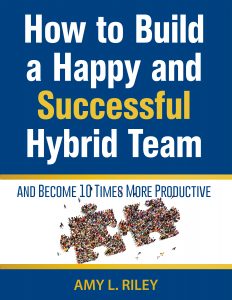
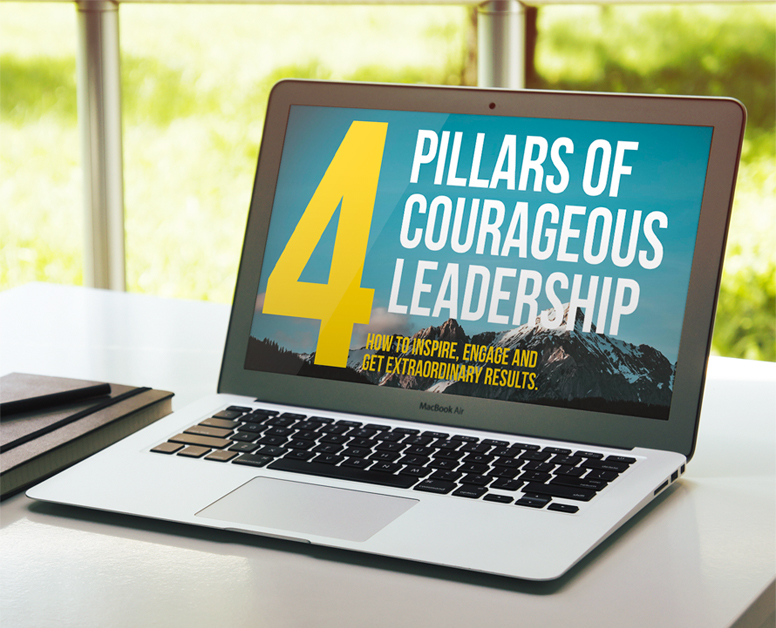 A Summary of The Courage of a Leader® 4 Pillars
A Summary of The Courage of a Leader® 4 Pillars